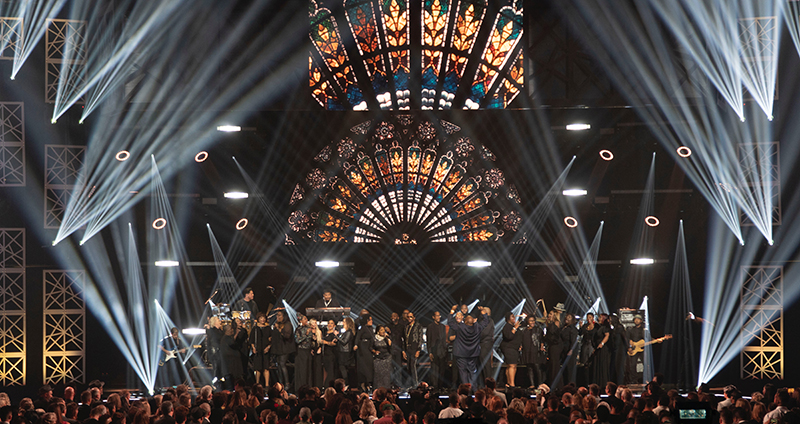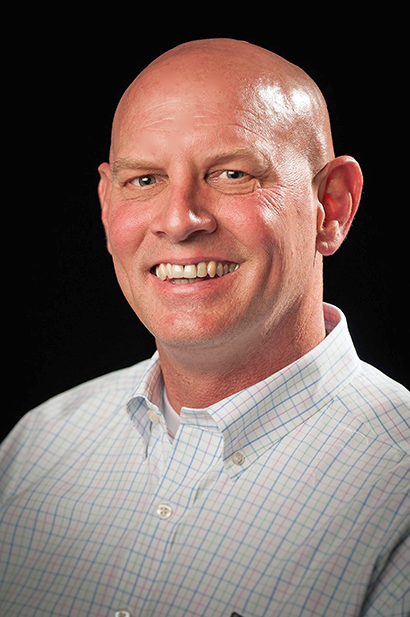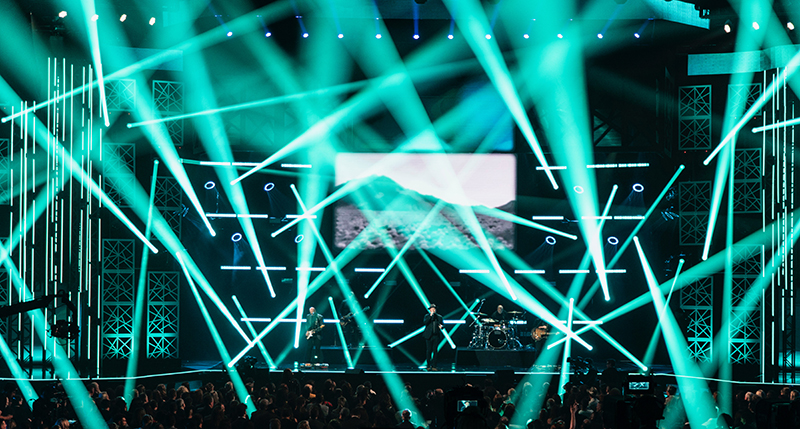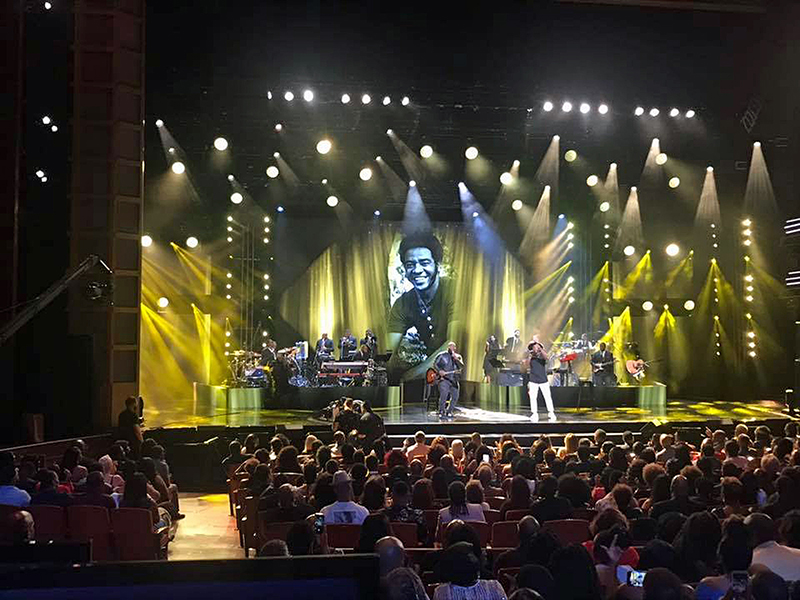
A Revered Designer Who Made His Mark by Staying Humble
Presidential debates, live television, awards shows, concerts, events of all size and scope — a full career of constant work and collaboration is all a person can hope for in this business. If you are talented, easy going (while having command of your work), and humble all in the same breath, you will work a lifetime of projects that will keep you busy and happy. One thing is for certain: when people keep calling you for repeat work because you are so much fun to be around as well as doing some great work, you’re living the good life. PLSN was fortunate to catch up with such a pleasant, professional lighting designer recently. Meet Mark Carver.

Sometimes, Nice Guys Finish First
Carver has turned a love of lighting into a career that has spanned over 35 years, having worked for a very long and distinguished list of performers and fellow lighting professionals alike. From award show work on the Stella Awards, the Country Music Awards (CMAs), to shows like the Dove Awards and the Trumpet Awards, Mark has been making beautiful live and televised work that millions of people have seen and loved.
“We love working with Mark Carver, he is an incredible talent and a great human being,” says Bandit Lites vice president Mike Golden. “It’s absolutely a pleasure to be around Mark every time we work with him.” Carver does many shows with Bandit Lites every year, and that relationship has been a lasting one. Through Bandit and from his own endeavors, Carver has worked with a litany of A-List performers from Dave Matthews Band to Willie Nelson, from George Strait to Jimmy Buffett. He’s also been doing this from the bottom up, beginning his career at a startup Country music channel called The Nashville Network, better known as TNN. Carver is a Nashvillian, born and raised in the hub of Country Music, touring shows, and life-changing live performances.
An On-the-Job Education
“I was on staff at the Nashville Network for a long time,” Carver says. “This was well before it was officially launched as TNN. I worked summers there while I was going to school, around 1982. I was running a spotlight in the summers, loving the work and absorbing the industry as I learned how to work it.” TNT became an official entity in 1983, operating on the campus of the Opryland USA theme park and the Grand Ole Opry House. “I was on staff at TNN right after college, having the time of my life,” Carver says. “I was working shows at the Opry House from about 1982, and I was a staff lighting designer on TNT right up until the end of 1999 when I started working for my company. It was the time of my life. Ted Wells was the head of lighting for the Nashville Network, and Ted was who hired me on.”
Carver expresses gratitude to Wells and others who illuminated the path toward visual excellence and a bright future career. “I loved working with those guys, and I learned so much from them on the trade,” Carver states, crediting Bill Klages, Bobby Dickinson and Bobby Davis along with Wells for their roles as teachers and mentors. “These people have real vision in their work.”
While Carver spent his time at The Nashville Network, the other network doing similar programming was Country Music Television (CMT), and after a change in location for TNN, which moved its main location to New York, the network began to decide that there was redundancy between its two properties, TNN and CMT.
That was 1998, and within a year, Carver and his colleagues would exodus from TNN and begin their freelance careers. Carver began Carver Lighting Design, and he continued to work with his mentors and friends. “Around 1999, we left the network for the freelance market, and I was lucky to get to do a lot of shows with Bill [Klages] and Bobby [Dickinson] and a lot of other great folks,” Carver says. “I got to work two Olympics with Bobby, the Summer Olympics in Athens, Greece in 2004, and the Winter Olympics in Salt Lake City in 2002. They were such exciting, very big shows.”

Gaffing for the CMAs
If you watch the CMAs or the Country Music Fest, you’re more than likely going to see Carver’s work. “Bobby [Dickinson] did the CMA Awards show for years, and now I have the privilege of working with Jon Kusner. I’ve been doing it for 35 years in one position or another, from gaffer to lighting director. It’s a great time, and the crew works very well together; I always look forward to it.”
Carver has spent most of his career working in television, learning plenty while working in a Best Boy role under Tony Ward, main gaffer at the Salt Lake City Olympics in 2002. “In many ways, gaffing on a show makes you even more prepared to be the lighting director or designer, because you make sure everything works for the team, and it’s your responsibility to get the design team the best performance out of the rig. You’re the site superintendent, and people look to you to be able to make the art.”
Along with the technical “ropes,” Carver picked up on the importance of staying humble in the midst of all that big-show fanfare. “I wasn’t in a hurry to be a star, I wanted to make the stars look as good as I possibly could, because that’s what I learned from the people I got to learn from. What they were doing was making the talent look great, giving the audience a good time, and making sure that the camera shots looked as good as can be. I had great role models as I got more proficient, and the more I worked and paid attention to my mentors, I got larger and larger shows. Once I was out in the freelance world, I continue to do nothing different than I have, which is, be glad to be there and work alongside people you value and respect.”
“I think for the last 19 or 20 years, I’ve been the gaffer on the CMAs. One of the reasons I keep doing the show and keep gaffing for it is that it’s just an honor to be a part of such a great team, and the experience is always to be enjoyed. It’s also the last of the shows I’m still gaffer on, and I think that’s a testament to how much fun we have doing the show every year. It’s icing on the cake really, because it’s very much like a family reunion. Most of the work I do nowadays is design work, but my career has been so interesting and very fun, and I have a very big loyalty to the CMA folks that it’s truly my pleasure to do that work, and I will continue to do it for many more years as long as I am healthy enough to keep standing.”
Instead of focusing on self-promotion, Carver tends to let his work speak for itself. PLSN recently reached out to discuss his designs for the International Pathfinder Camporee (PLSN, Sept. 2019, page 38), a week-long Music and Worship festival held every five years. Carver was recommended to the promoters of the festival, and together they made a very well received production for the festival goers.
“I feel very fortunate to have an idea of what I’m doing, and I’d rather that come through in the work than it be promoting me personally, because if it weren’t for these artists and events, we wouldn’t have a career,” Carver states. “I have never been one to feel very good about self-promoting or toot my own horn. I’d rather just let the body of work speak for itself, and I try to be a good person, that’s always number one to me. When we’re working, whoever we are working for is to be cast in the best light possible, and to make them look as good as possible, putting them in the center of attention. Nobody’s paying to come see me, that’s for sure, and they’re not paying to come see some pretty lights alone, and I’m glad that was always the rule when I was coming up in this business. You have to understand your role, and I think that I’ve always had it in my head that my job is to place that artist at the head of the table and feel good that they looked great. It’s a show, not a light show, right? We’re not the stars here, we’re the humble servants. I have a son coming up in the industry right now too, and I teach him everything I can about what we do, including how to be a good person.”

Lighting the Main Attraction
Carver also resists the temptation to detract from the focus of his shows with lighting effects overkill, even as the fixtures now at his disposal could be easily unleashed to do just that. “Technology has grown so fast in the span of our production lifetimes, and many times we are pushing the limits of what can be done with the gear,” Carver says. “But if we overdrive the look, if we push too far past what the artist is capable of, we’ve done a great disservice to the artist, and that is not our jobs — we’re to make you notice the artist, not the lighting. At the end of the day, none of this is about me, I’m here to make that person or group have the best day or night of their career, fully balanced and appropriate for the moment.”
While Carver’s approach might seem the antithesis of self-promotion, it has served him well in advancing his own career, and he offers it as guidance for others who are seeking to make their mark in television lighting. “This industry has been strange over the many years I’ve been in it, but what never changes is the core principle that you have a responsibility to make the artist look great to whomever the audience happens to be, and that changes as well, from live audiences to televised audiences,” he states. “It doesn’t matter to the artist whether they’re being seen in a frame on TV by millions or a live audience of thousands — the lighting needs to draw attention to the artist and not distract from them; you must give the talent their due and always maintain balance. Sometimes, as well, during a live show, you’re dealing with both what the audience sees and what the camera shot has in frame, and that balance of keeping the attention on the talent is critical. Think of it like this, if you feel like you’re distracted with the look, you’re probably distracting from the talent.
“There’s showmanship on many levels, both from the lighting designer and from the artist,” Carver continues. “I work with a lot of young LDs who want that big showmanship experience, and some LDs get it right off the bat — being a showman in lighting is being the humble servant to the best look for the talent, and that really is the key to the job. There are plenty of times where lighting will have chances to show off all of the technology that we have and make grand looks, but each artist knows how much of that they want. It’s our responsibility to talk with the artist and their team and find out, beyond giving them central attention with your lighting. Not everyone is into the subtlety thing, but more times than not, everyone has a limit, and some artists will let you push the envelope further than others. Just remember that you’re there for them, no matter what.
The Opportunity to Learn Continues
“All of us out here have been through that ‘school of hard knocks’ and have learned some things from great people, but you will also do yourself a big favor if you are always willing to listen and learn from the people who know more than you,” Carver concludes. “What is just as critical is not putting a limit on who you can learn from, because I learn something from the young guys as well as from my colleagues, still. With the technology available now, the younger generation is pushing that technology and using it in ways that appeal to everyone. I try to learn something new every day, from anyone and everyone.”


